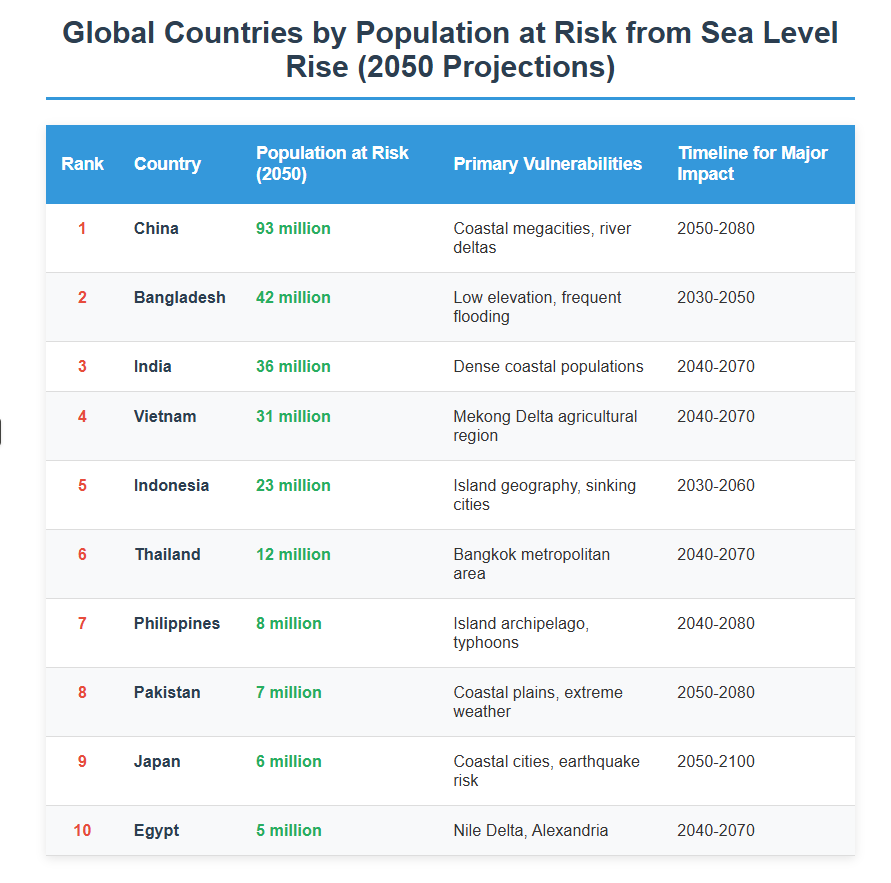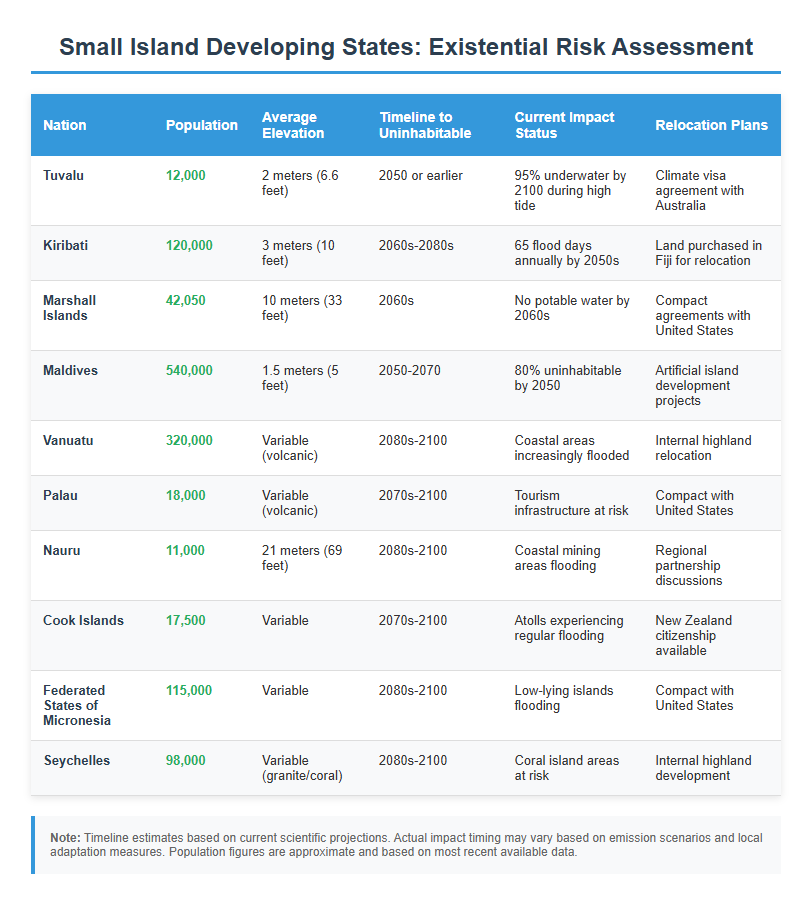Summary
Samut Prakan, Thailand
I decided to do a more thorough analysis (with assistance of an AI analysis tool I pay for monthly), considering my condo is perched on a cliff less than 50′ above the Pacific Ocean in Whittier, Alaska. See initial US Report. As I have been chased down by half a dozen typhoons and floods over the past few years while traveling around Asia and Oceania, I’m trying to get a bigger mental picture of what’s going on. I don’t worry too much about anything really, because I know my mobility and survival capabilities. But that doesn’t mean I don’t plan ahead, continuously assess risks and minimize future setbacks regarding personal safety and investment portfolio.
On the long-term horizon, flooding has historically been an insurable event but as owners in many coastal areas are finding out, insurance payouts are not always guaranteed. As I go about my day-to-day 99% of the time, it’s always interesting to take a step back to look at some of the outliers – astronomical and terrestrial extinction events, record-breaking earthquakes, tsunami, short and long-term cycles humans normally don’t think about.
Then, there are the events that happen every day that we might be impacted by but don’t do much about, unless you take note of every little observation, add them all up, and take a moment to ask “Why? or So what?”
Global sea level rise presents a significant long-term challenge that will reshape coastal regions worldwide over the coming decades. While the impacts will be gradual in most areas, providing time for adaptation, certain regions face more immediate risks that warrant strategic planning and investment considerations.
This report provides an objective assessment of regional vulnerabilities, population displacement projections, and identifies geographic areas with greater resilience potential for investment and resettlement planning.
-Jerami
Key Global Findings:
- Current Population at Risk: 680 million people live in low-lying coastal zones, projected to exceed 1 billion by 2050
- Regional Concentration: 70% of global exposure concentrated in eight Asian countries
- Timeline: Most significant impacts will occur between 2050-2100, allowing time for adaptation
- Investment Opportunities: Higher elevation inland regions present strategic advantages for long-term development
Global Sea Level Rise Projections
Current Rates and Acceleration
Global average sea level has risen 8-9 inches since 1880, with the rate accelerating from 1.4mm annually in the 20th century to 3.6mm annually from 2006-2015. Current projections indicate:
- Conservative Scenario (Low Emissions): 1 foot rise by 2100
- Intermediate Scenario: 3 feet rise by 2100
- High-Impact Scenario: 6.6 feet rise by 2100
Regional Variations
Sea level rise will not be uniform globally. Some regions will experience higher rates due to:
- Ocean circulation changes
- Land subsidence
- Regional climate patterns
- Glacial isostatic adjustment
Most Vulnerable Regions and Countries
Asia-Pacific: Highest Concentration of Risk
Major Countries by Population Exposure (2050 projections):

Timeline for Major Asian Cities:
- Jakarta, Indonesia: Capital relocation to Borneo already approved
- Bangkok, Thailand: Flood management systems being enhanced
- Shanghai, China: Advanced coastal protection infrastructure planned
- Dhaka, Bangladesh: Significant challenges, international assistance needed
Small Island Developing States: Existential Challenges
Pacific Islands Requiring Resettlement Planning:

Migration Support Systems: Several developed nations are establishing climate migration pathways:
- Australia’s climate visa program for Pacific islanders
- New Zealand’s humanitarian visa categories
- European Union climate mobility initiatives
Africa and Middle East: Emerging Vulnerabilities
Key Affected Areas:
- Alexandria, Egypt: Hundreds of thousands may require relocation within decades
- Lagos, Nigeria: 15.3 million people in potential impact zone by 2100
- Coastal West Africa: Multiple cities facing increasing flood frequency
Europe: Advanced Adaptation Capabilities
Vulnerable Regions:
- Netherlands: Comprehensive flood management systems, world leader in adaptation
- Venice, Italy: Advanced barrier systems in operation
- Thames Estuary, UK: Major flood defenses planned and implemented
Strategic Opportunities: Climate-Resilient Investment Locations
North America: High-Elevation Inland Regions
Prime Investment Areas:
United States:
- Colorado Front Range: Denver, Boulder, Fort Collins
- Advantages: High elevation (5,000+ feet), growing tech sector, stable water supply
- Investment Focus: Technology, education, sustainable development
- North Carolina Piedmont: Raleigh-Durham, Charlotte
- Advantages: Moderate elevation, strong economy, inland location
- Investment Focus: Research, finance, manufacturing
- Tennessee Valley: Nashville, Knoxville region
- Advantages: Landlocked, diverse economy, growing population
- Investment Focus: Healthcare, music industry, logistics
- Texas Hill Country: Austin, San Antonio suburbs
- Advantages: High elevation areas, economic growth, tech industry
- Investment Focus: Technology, renewable energy, education
Canada:
- Ontario Highlands: Ottawa, Kingston region
- Alberta Foothills: Calgary, Edmonton areas
- British Columbia Interior: Kelowna, Kamloops region
Europe: Inland Mountain and Highland Regions
Strategic Locations:
Switzerland:
- Alpine regions with established infrastructure
- Political stability and strong financial systems
- Investment focus: Sustainable tourism, finance, technology
Germany:
- Bavaria and Baden-Württemberg highlands
- Strong manufacturing base and research institutions
- Investment focus: Advanced manufacturing, renewable energy
Scandinavia:
- Northern Sweden, Finland interior regions
- Emerging as climate havens with stable governments
- Investment focus: Green technology, forestry, mineral resources
Asia-Pacific: Elevated Inland Areas
Australia:
- Blue Mountains region west of Sydney
- Adelaide Hills and Barossa Valley
- Toowoomba and Darling Downs, Queensland
New Zealand:
- Central Otago region
- Canterbury Plains (elevated areas)
- Hawke’s Bay highlands
South America: Andean Regions
Strategic Locations:
- Medellín, Colombia: High elevation, moderate climate, growing economy
- Quito, Ecuador: High altitude, established infrastructure
- Montevideo, Uruguay: Higher elevation areas, stable political system
Economic and Investment Considerations
Infrastructure Investment Opportunities
Renewable Energy Infrastructure: Higher elevation regions often have superior wind and solar resources, presenting opportunities for:
- Large-scale renewable energy projects
- Grid modernization and storage facilities
- Green hydrogen production facilities
Water Management Systems: Inland regions will become increasingly valuable for their freshwater resources:
- Watershed protection and management
- Advanced water treatment facilities
- Sustainable agriculture systems
Transportation Networks: Climate migration will drive demand for:
- High-speed rail connections between coastal and inland areas
- Modern airport facilities in emerging population centers
- Advanced telecommunications infrastructure
Real Estate Investment Strategy
Short-term Opportunities (2025-2040):
- Coastal adaptation infrastructure projects
- Elevated areas within existing metropolitan regions
- Climate-resilient residential and commercial developments
Long-term Positioning (2040-2070):
- Inland cities with sustainable water supplies
- Higher education and research centers in climate-stable regions
- Renewable energy production zones
Risk Management Considerations:
- Diversification across multiple geographic regions
- Focus on areas with strong governance and adaptive capacity
- Investment in regions with established infrastructure and services
Population Displacement Patterns and Opportunities
Migration Destination Analysis
Factors Driving Destination Selection:
- Economic Opportunities: Job markets and industry presence
- Infrastructure Quality: Transportation, utilities, healthcare
- Climate Stability: Moderate temperatures, reliable precipitation
- Governance: Political stability and adaptive capacity
- Cultural Factors: Language, community networks, lifestyle
Emerging Climate Migration Hubs:
North American Corridors:
- Pacific Northwest inland valleys
- Great Lakes region (avoiding immediate shorelines)
- Appalachian highlands
- Canadian prairie provinces
European Inland Centers:
- Central European highlands
- Scandinavian interior regions
- Alpine valleys with infrastructure
Community Development Opportunities
Planned Climate Communities: Several regions are proactively developing climate-resilient communities:
- Eco-cities in China: Tianjin and other inland sustainable urban developments
- European Green Capitals: Cities implementing comprehensive sustainability programs
- North American Climate Havens: Communities marketing themselves as climate-safe destinations
Adaptation Technologies and Investment Sectors
Infrastructure Resilience
Smart City Technologies:
- Advanced flood monitoring and early warning systems
- Resilient communication networks
- Autonomous transportation systems for emergency response
Building Technologies:
- Elevated foundation systems
- Amphibious and floating structures
- Advanced materials for saltwater resistance
Agricultural Innovation
Climate-Adapted Agriculture:
- Vertical farming and controlled environment agriculture
- Salt-resistant crop varieties
- Precision irrigation systems
- Alternative protein production facilities
Financial Services Evolution
Climate Risk Insurance:
- Parametric insurance products
- Climate migration financing
- Resilience bonds and green finance instruments
Policy and Governance Considerations
International Cooperation Frameworks
Climate Migration Agreements:
- Regional compacts for managed migration
- Skills-based climate visa programs
- International funding mechanisms for adaptation
Maritime Boundary Preservation:
- Legal frameworks to maintain territorial waters despite land loss
- International treaties for stateless populations
- Resource sharing agreements for displaced communities
Investment Protection Strategies
Legal Considerations:
- Climate disclosure requirements for real estate
- Adaptation planning mandates
- Insurance availability and requirements
Risk Assessment Tools:
- Sea level rise mapping and modeling
- Economic impact assessments
- Long-term demographic projections
Recommendations for Strategic Planning
For Individual Investors
Near-term Actions (2025-2030):
- Diversify Geographically: Reduce concentration in coastal real estate
- Research Climate Projections: Use scientific data for location decisions
- Invest in Adaptation: Support infrastructure and technology solutions
- Monitor Policy Changes: Track government adaptation and migration policies
Long-term Positioning (2030-2050):
- Focus on Elevation: Prioritize higher-ground properties and communities
- Sustainable Resources: Invest in areas with reliable water and energy
- Economic Fundamentals: Choose regions with diverse, knowledge-based economies
- Community Resilience: Support locations with strong social capital and governance
For Institutional Investors
Infrastructure Investment Priorities:
- Climate-resilient transportation networks
- Renewable energy and storage systems
- Advanced water management facilities
- Sustainable housing and commercial developments
Geographic Diversification Strategy:
- Balance between adaptation opportunities in vulnerable areas and long-term positioning in climate-stable regions
- Consider both developed markets with strong adaptation capacity and emerging markets with growth potential
Conclusion
Global sea level rise represents a manageable long-term challenge that will create both risks and opportunities over the coming decades. While certain coastal regions and small island states face significant challenges, the gradual nature of most impacts provides time for strategic adaptation and planned migration.
The key to successful navigation of this transition lies in:
- Early Recognition of changing conditions and opportunities
- Strategic Positioning in climate-resilient locations with strong fundamentals
- Diversified Investment approaches that balance risk and opportunity
- Community Engagement in adaptation and resilience planning
Rather than viewing sea level rise solely as a crisis, forward-thinking investors and planners can identify opportunities to support sustainable development in climate-stable regions while contributing to adaptation efforts in vulnerable areas. The transition will create demand for new infrastructure, technologies, and community developments that can provide both social benefits and financial returns.
Success in this changing environment will require objective assessment of scientific projections, careful evaluation of regional adaptation capabilities, and strategic investment in the geographical areas and economic sectors best positioned for long-term sustainability and growth.
This report synthesizes current scientific consensus from IPCC, NASA, NOAA, and peer-reviewed research. Investment recommendations are for informational purposes and should be evaluated alongside professional financial and legal advice. Climate projections involve uncertainty, and actual conditions may vary from current scientific projections.
Leave a Reply